The Culture Box is a unique, but often lesser known part of community outreach programming for many members of the Global Ties Network. In this article, two of our members share how they use Culture Boxes to bring the world to their communities.
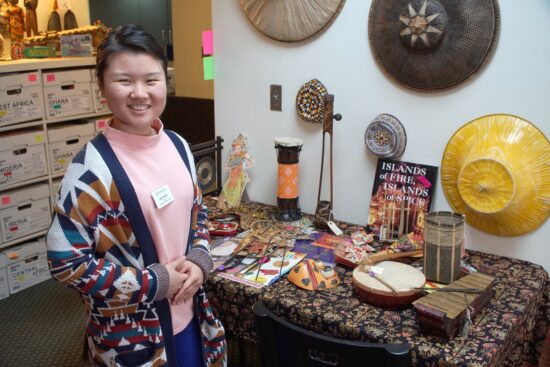
Lifia Teguh, a student at Portland State University from Indonesia, presents at the “Invite the World to your Classroom with Culture Boxes” Workshop. Photo credit: WorldOregon
CULTURE BOXES BRING THE WORLD TO THE CLASSROOM
By Derrick Olsen, Amy Barss, Tim DuRoche, Karen Ettinger
The Global & Multicultural Resource Center is a central part of WorldOregon’s Global Classroom. Its most outstanding feature is an extensive, 30-year collection of Culture Boxes representing over 100 countries. These boxes are filled with hands-on, authentic artifacts and lessons about the art, culture, and daily life of people from almost every continent.
OUR 30-YEAR JOURNEY
The Culture Box Program began in 1987 when founder Karen Ettinger and a group of parent volunteers in Lake Oswego, OR received $600 from the National Association of Elementary School Principals to create Culture Boxes on five regions of the world. The parents wanted to help expose children in the suburbs to the world and teach them about world cultures. With full support from the school district, Culture Boxes began to grow and were soon being shared across the district.
In 1997, the Culture Box Program became a community program at Portland State University (PSU) within the Office of International Affairs and similar organizations, including Building Bridges, the United Nations Association, Oregon Peace Institute, and the PSU Middle East Studies Center. In 2002, the Culture Box Program joined WorldOregon under now-U.S. Senator Jeff Merkley’s leadership. It continues to thrive and grow to this day.
CULTURE BOX WORKSHOPS
In 2017, WorldOregon began offering Culture Box Workshops for teachers. The experience inspired WorldOregon to build broader partnerships with other schools and bring teachers together at an annual workshop focused on bringing the world to the classroom.
Some of the workshop highlights include:
Talking with people and students from other countries
- Exploring the boxes and brainstorming how to use them
- Learning how to enhance the cultural competency of students using speakers and objects from various countries
- The round-about where teachers switch tables and talk to different people
- Creating a lesson together and collaborating on different ways to use the boxes
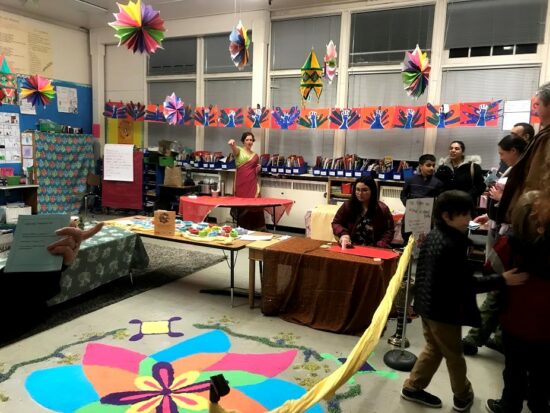
CULTURE BOXES FOR EDUCATORS AND THE COMMUNITY
During the 2017-18 school year, 229 Culture Boxes were enjoyed by approximately 12,000 students in the Portland area, including after school programs. Additionally, 13 elementary schools organized multi-week Cultural Immersion Programs that involved the entire student body and community. Teachers who borrow a Culture Box are encouraged to invite an international student from PSU, a Peace Corps volunteer, or a parent or community member to help bring the Culture Boxes to life. International guests are also invited to table at events using Culture Box materials.
Over the years, this program has transformed their school and continues to build a new generation of global citizens.
SENDING VIRTUAL BOXES ACROSS OREGON
Virtual Culture Boxes are a recent development that feature reference libraries, lessons, activities, and curricula on Culture Boxes. They also include information on world regions and address important global issues, such as multiculturalism, anti-bias, civil, and human rights.
The creation of Virtual Culture Boxes has been well-received. WorldOregon will continue to build out this resource to connect with other parts of Oregon that may be too far away to borrow hands-on Culture Boxes. As one program testimonial puts it:”The online Culture Box was great! I loved having easy access to videos and information that someone had found useful. It saved me so much time and really added to student learning!”
Visit WorldOregon’s website for more details.
THE WORLD IN A BOX
By Bob Lieser, Vice President of Programs and Interim Director, and Cathy Izzo, Sister City Program Coordinator and Administrator, Tulsa Global Alliance
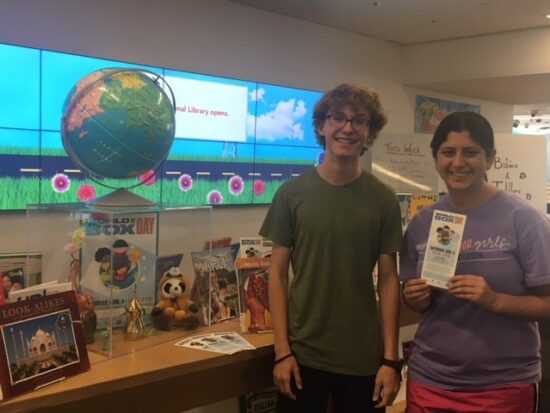
Nate Ijams (left) and Riya Kaul help chair a World in a Box Day event in Tulsa, OK. Photo credit: Tulsa Global Alliance
Culture Boxes are a cherished resource at the heart and soul of the global education mission of Tulsa Global Alliance (TGA). Although they appear simply as large plastic bins, they contain artifacts, coins, clothing, books, maps, toys, and more from over 50 countries and cultures.
The Culture Box Program was founded in the mid-1980s by Phil and Emily Wood of Tulsa, OK, while chaperoning their son’s language trip to Japan. Three weeks of school, homestays, and travel yielded a treasure trove of items that they wanted to keep and display. Emily, who was also a middle school teacher, boxed these items to share with colleagues, and then developed a curriculum to accompany them.
The program was an instant success, producing increased enthusiasm for global learning. Boxes highlighting other countries were soon developed thanks to donations from other overseas travelers, as well as the Turkish American Society and Dillion International (South Korea).
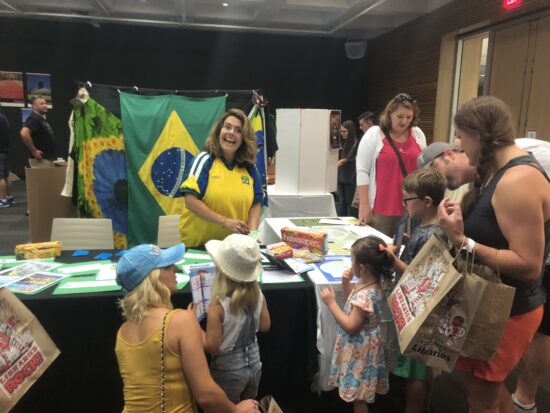
The Brazilian Booth and Culture Box presentation at a World in a Box Day event in Tulsa. Photo credit: Tulsa Global Alliance
When the French and Spanish immersion schools opened in Tulsa in the early 1990s, Emily began teaching there and the Culture Boxes found a new home. Over the years, Tulsa Global Alliance partnered with her and the school to expand the program as travelers returned home with items for existing culture boxes or for new culture boxes. Today, there are over 50 boxes available to all students, teachers, scout troops, and international organizations as a global education resource.
The Culture Box Program has recently expanded in creative ways. In 2016, as part of a Girl Scout Gold Award project, TGA presented the inaugural World in a Box Day event for children and families in partnership with the Tulsa City County Library system. This festival highlighted Culture Boxes and included hands-on activities, storytelling, and entertainment from countries around the world.
Coincidentally, the Iraqi Young Leaders Exchange Program students in 2016 and 2018 also participated in the event and donated items for a new Iraqi Culture Box. World in a Box Day has expanded and continues to be the centerpiece of “Passports to Global Cultures,” TGA’s Global Education program.
Additionally, Emily prepares a display at her senior living facility each month to showcase a country with a Culture Box. Many residents have traveled extensively and often bring their own souvenirs to the discussion. They continue their learning with a lunch at an ethnic restaurant.
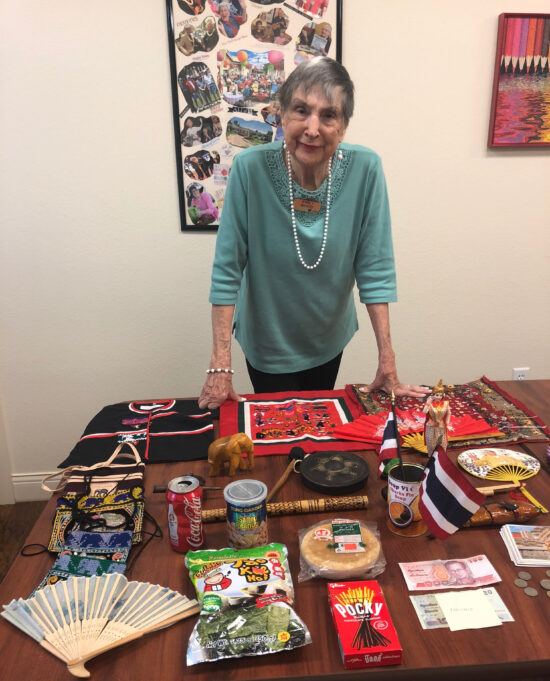
Emily Wood presents the Culture Box for Thailand at her senior living facility in Tulsa, OK.
The Culture Box Program provides hands-on global education for all ages, and proves that we are never too young or too old to learn about the world and its cultures.
Visit Tulsa Global Alliance’s website for more information.
